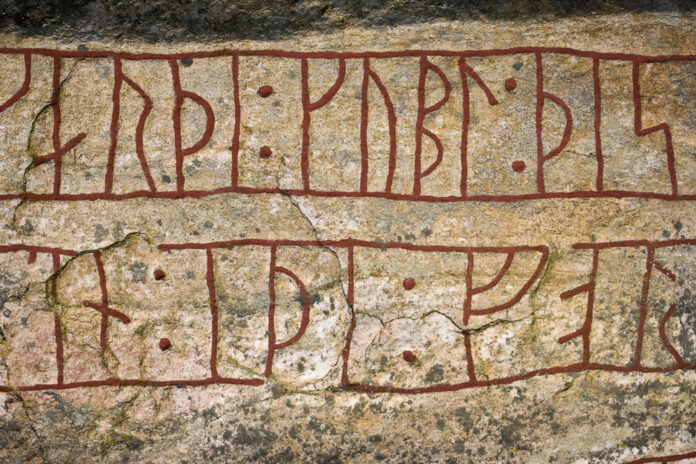The enigmatic origins of runic writings used by early Germanic peoples have invited much debate over the years, but a fragmented runestone from a Norwegian grave site may settle some questions.
Researchers found that several pieces of sandstone, excavated from the Svingerud grave field in Hole, Norway and dated to between 50 B.C.E. to 275 C.E., fit together into a single slab that contains perplexing runic inscriptions.
The meanings behind these carved markings are explored in a new study published in the journal Antiquity. Researchers believe that the Svingerud Stone may have been intentionally segmented to designate certain inscriptions to different graves. With the runestone fragments reunited, the connections among the varied inscriptions offer promising progress toward understanding the earliest incarnations of Germanic runes.
The Oldest Runestone
Fragments of the Svingerud Stone were initially found during excavations led by the Museum of Cultural History, associated with the University of Oslo, from 2021 to 2023. Radiocarbon dating allowed researchers to determine that the fragments originated somewhere between 50 B.C. and 275 C.E., cementing the Svingerud Stone as the oldest known runestone. Many identified runestones come centuries later in history, during the Viking Age (around the 9th to 11th centuries).
The sandstone pieces were primarily dispersed in three graves, designated Hole 1, Hole 2, and Hole 3: Hole 2 contained the main runic fragment, while Hole 1 contained a large slab, and Hole 3 contained several additional fragments. Researchers assembled these components into a single runestone, although some portions of the stone are still missing.
Deciphering Names and Shapes
Multiple inscriptions — along with other visual elements like triangular and zig-zag shapes — were found carved along the runestone, although the portion from Hole 2 served as the primary focus for researchers. Many of the runic sequences consisted of ambiguous markings, and minor damage on certain sections further complicated analysis. However, the researchers gathered clues from a few of the sequences that may hint at their meaning.
One of the sequences, for example, includes eight runes that read “idiberug.” The researchers say this could represent the name of a deceased individual or someone or something else — and the person it was referring to was likely a female based on the name.
A separate sequence has characters that resemble the first three runes of the futhark, the early Germanic alphabetical system that was used to write Proto-Norse (the first three runes correspond to the sounds “f,” “u,” and “th”). The researchers state that this could have been an early written depiction of the futhark.
An inscription on the Hole 3 portion includes the noun “runo” (referring to “rune”) and the verb “fahido” (referring to “painted/wrote” or the act of inscribing). A name or epithet may also be attached to the same sequence, although scratches on this section made it difficult to assess. The name appears to end in a “u,” which would show that the carver was female.
The Emergence of Runes
Along with the markings that seem to represent the Proto-Norse language, the presence of various shapes could simply be a sign that that engraver was testing out how to write, since the idea was new to Germanic peoples around this time.
They may have been inspired to start writing runes by the Latin alphabet, as the Romans began interacting with them somewhere around the 2nd century B.C.E. In addition to communicating language, some runes also had a mythological connection, being linked with deities in Germanic paganism.
The runic alphabet eventually evolved to reflect the transition from the Proto-Norse language to Old Norse in the 8th century, and it was used up until the 14th century, when Christianity — and by proxy, the Latin alphabet — had become widespread across Europe.
Read More: What Language Did the Vikings Speak?
What Purpose Did Runestones Serve?
The purpose behind the Svingerud Stone is still up in the air, but the new study notes that it is likely meant to be a commemorative creation dedicated to the deceased. This kind of commemoration was seen later during the Viking Age, as the Vikings would honor the dead (often leaders) with runestones. A common phrase on a stone would read something like “X raised this stone for Y,” usually referring to a dead relative.
The researchers say that the Svingerud Stone may have been meant to mark one grave at first, but was later fragmented for subsequent burials. The runestone will need to undergo closer examinations, though, to fully understand how it fits in with the inception of Germanic writing.
Article Sources
Our writers at Discovermagazine.com use peer-reviewed studies and high-quality sources for our articles, and our editors review for scientific accuracy and editorial standards. Review the sources used below for this article:
Jack Knudson is an assistant editor at Discover with a strong interest in environmental science and history. Before joining Discover in 2023, he studied journalism at the Scripps College of Communication at Ohio University and previously interned at Recycling Today magazine.
Source : Discovermagazine






